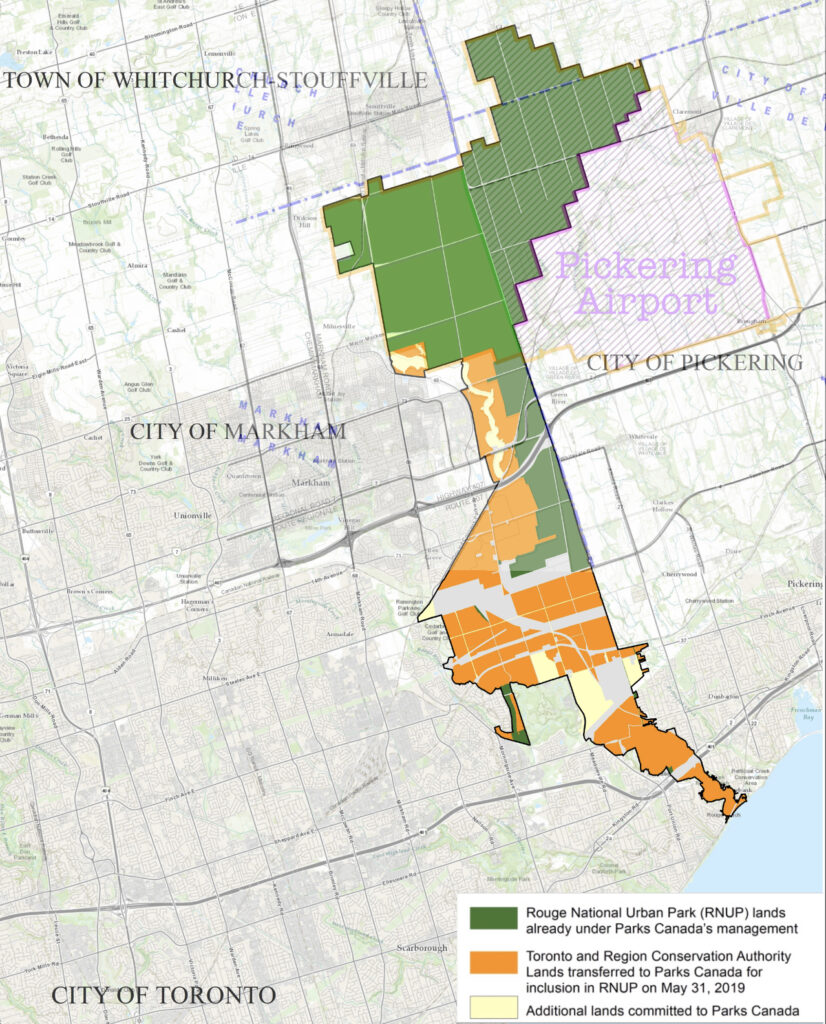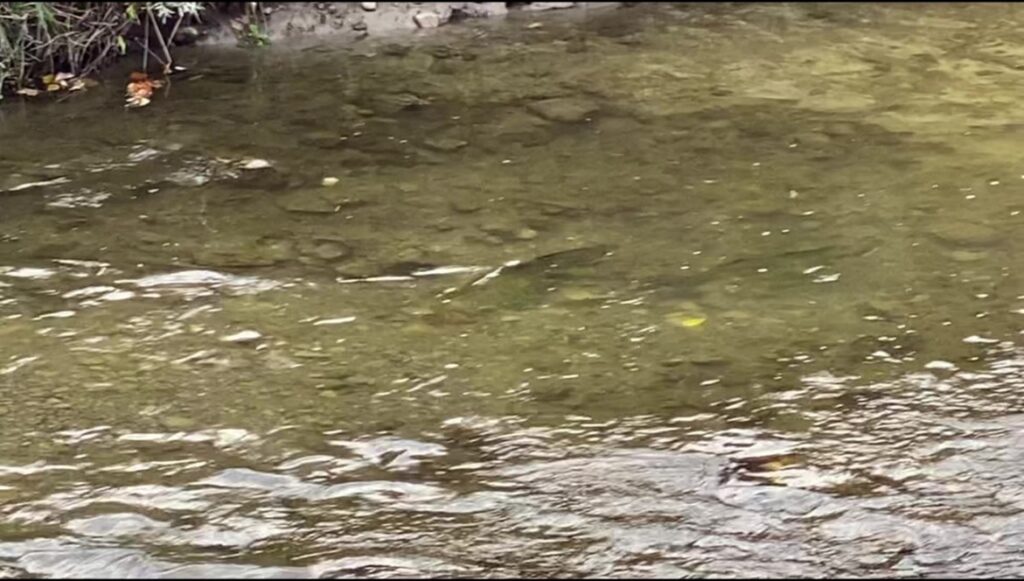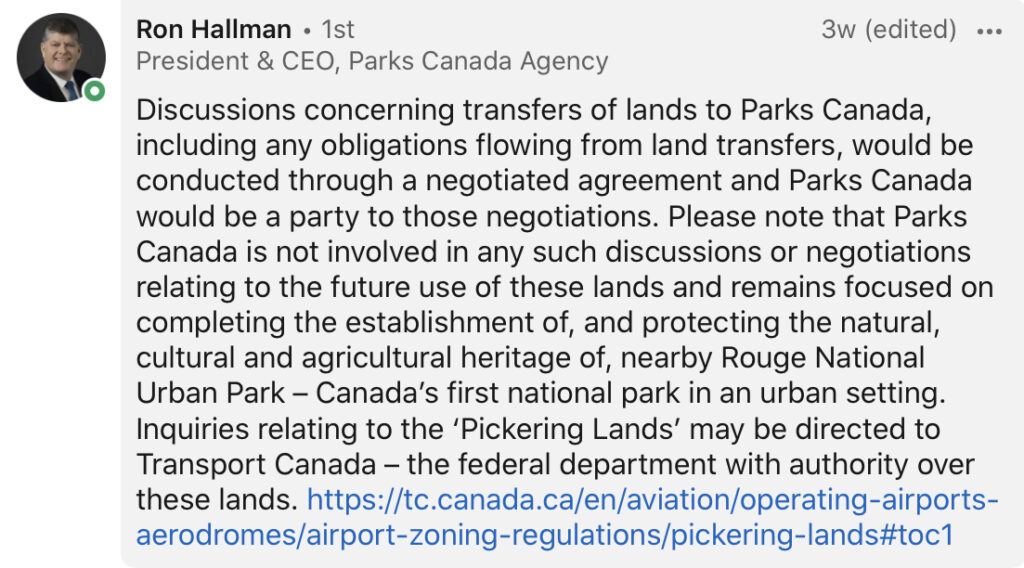By Ted Nickerson and Mark Brooks
On October 10, 2020, Friends of Pickering Airport posted a report, ”Who is Leasing the Pickering Airport Lands?”, looking at the number, type and lessees of the Pickering Airport lands that have been retained for economic development including an airport. The new airport will be adjacent to the Rouge National Urban Park (RNUP). For a complete picture, It is important to look at the agriculture leases in the RNUP, especially on the lands formally part of the Pickering lands transferred to it and that are expected to play an important role as a greenspace buffer for the airport.
A decade ago, it was clear that the federal land assembly was far in excess of what was needed for the type and role of the new Pickering airport. Airport design and aviation technology has advanced. The idea of an airport east of the CP Havelock Subdivision rail line made sense. Urban planning by the surrounding municipalities is enabling a clearer understanding of the long-term development of the region.

We supported the transfer of lands by the federal government (J. Flaherty in 2012 and S. Harper in 2015) to the evolving RNUP. These dedications serve as a buffer between the airport and noise sensitive uses to the west of an airport, and permit agriculture to continue as viable businesses while providing expanded environmental protection on those lands.
Though not in as much detail, the information regarding agriculture in RNUP was obtained through a friendly and courteous interaction with the RNUP representative, Jeffrey Sinibaldi. An FOI (Freedom of Information) request was not needed.
Jeffrey Sinibaldi is the Acting External Relations Manager & Senior Advisor, Corporate and Community Engagement Rouge National Urban Park / Parks Canada / Government of Canada.
The Parks Canada representative identified:
- There are 219 agriculture parcels in RNUP.
- There are 114 agriculture leases covering these parcels.
- The leases are held by 57 lessees.
- Those lessees run 85 farming operations.
Some lessees have more than one parcel of land as part of their lease, and some lessees have more than one lease in the park. Those 85 farm operations currently make up about half of the park lands. That works out to about 3,100 hectares (7,800 acres). How much of that came through the recent federal airport land dedications was not provided.
Farmers in the park grow vegetables, fruit, corn, soy, wheat and mixed grains, amongst other crops.
As supporters of a Pickering Airport and for consistency with the previous posting, we are particularly interested in the agriculture leases in the federal airport lands that were transferred to RNUP. The reason is that today, five large commercial farms are leasing the majority of the Pickering lands. We suspect that the same might be true or could become true for the RNUP leases.
On the retained Pickering lands, 55% of both the total lands and the agriculture lands is leased to just five big commercial farms. The “Big Five” are Tapscott, Reesor/Burkholder, Stouffville Farms, L&J Farms, and 1018105 Ontario Inc. (Hunter Farms).
Although helpful, the information provided to us by Parks Canada, coupled with the concern noted above of who controls the majority of the lands, raises questions regarding the long-term future of agriculture in the RNUP that Parks Canada should address as it moves forward including:
- Is the majority of the agriculture lands within RNUP controlled by just a few lessees?
- Do the big five commercial farms that control the majority of the Pickering airport land leases, or a similar concentration of businesses, also control the majority of agricultural land leases in the RNUP?
- Will leases be shifted from the control of the commercial farms to young farmers looking for a start?
- How much of the land transferred to the RNUP will remain leased for agricultural purposes?
- Will these agriculture leases be reduced over time?
- How will Parks Canada balance the for-profit interests of these commercial farms with the need for transparency and the interests of millions of Canadians looking to enjoy the park?
- Given the other uses of the surrounding park land, will there be restrictions on the type of crops, the use of fertilizer and or pesticides in the park?
- Will new large agricultural infrastructure, such as the football field sized green houses as seen around the St Catherine’s airport and indoor farms, be allowed in RNUP?
Parks Canada is looking to the future of agriculture in RNUP.
In terms of training the next generation of farmers, as it builds its agricultural programming and capacity in the park, Parks Canada stated it is committed to providing a wide range of opportunities for new and apprentice farmers as agricultural lands become available in the park through an open and transparent process and via partnerships with post secondary institutions.
- Since the Ontario government already funds dozens of agricultural innovation and training centers across the province in a $1.5 billion dollar program in cooperation with a number of colleges and universities, will the RNUP be partnering with one specific University or college or will it partner with the Ontario provincial government?
The Rouge National Urban Park Act encourages “sustainable farming practices to support the preservation of agricultural lands in the park,” which lends itself to new opportunities that will demonstrate how agricultural best management practices can work together to support soil and water quality, local food production, ecological gains, and recreational opportunities on or adjacent to park farmland.

In terms of the agricultural leases, Parks Canada has quite a task before them as they transition park farmers from their current (Transport Canada) leases to Parks Canada agricultural leases. To that end, they have consulted deeply with the park farming community on all aspects of this transition.
The Parks Canada representative has stated that any new leases signed in the park will be based on a fair return to the Crown (through appraised market values) and would provide a term length of up to 30 years. Lessees would be expected to contribute to all aspects of the park’s mandate, including the preservation of the park’s natural, cultural, and agricultural heritage. While that may be second nature for a family or organic farm, it could be a tall order for the commercial farm growing genetically altered crops.
As has been reported in other postings by Friends of Pickering Airport, Parks Canada was not aware of MP O’Connell’s petition to transfer the retained federal Pickering lands to RNUP, nor, according to CEO Ron Hallman, has Parks Canada been involved in any discussions or negotiations to that end. That the MP sponsored this petition without first consulting Parks Canada is troubling.

The federal lands retained for economic development will accommodate significant employment district and a major airport. The 2012/2015 transfers of about 10,000 acres of federal Pickering airport lands to Parks Canada for the new Rouge National Urban Park made sense. It is the best use for those excess lands.
Rouge National Urban Park and Pickering Airport, with proper due diligence, need to do more than just successfully co-exist. They must build a synergistic relationship. The key to that successful relationship will be transparency, open dialog and cooperation between Parks Canada, all levels of government and the new airport.
Related posts:
Is Parks Canada Being Set Up for a Nasty Surprise? – Friends of Pickering Airport
Who is Leasing the Pickering Airport Lands? – Friends of Pickering Airport
Pickering Airport’s Heat Island Advantage – Friends of Pickering Airport
Will building Pickering Airport help or hurt Toronto’s food security? – Friends of Pickering Airport
Land Over Landings Billion dollar ask of the Canadian tax payer. – Friends of Pickering Airport
Failed Anti-Airport Petition raises big Questions – Friends of Pickering Airport
References:
Rouge National Urban Park (pc.gc.ca)
Liquid Fertilizer Spill in the Rouge River by Nicholas Giang (prezi.com)
City of Markham staff report on the RNUP